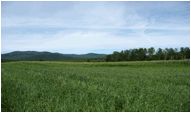DACF Home → Bureaus & Programs → Bureau of Agriculture → Agricultural Resource Development Division → Farmland Protection → Farmland Registration
Farmland Registration


On this Page:
- About Farmland Registration
- How to Register Farmland
- How to Re-Register Farmland
- Withdrawing Farmland Registration
About Farmland Registration
In 1988, the Maine Legislature enacted a voluntary farmland registration program aimed at protecting the ability of farmers to engage in common agricultural activities with minimal potential for causing harm to their neighbors. The legislation provides covenants to farmland registered with their local government. Owners of farmland must provide disclosure to adjacent properties and the public about setback restrictions on specific types of development on abutting land in immediate vicinity of active farming operations.
Any farmland owner electing to register their farmland after July 1, 2012, may prohibit Incompatible Use within 50 feet of registered farmland.
- Incompatible Use means the construction of new wells, drinking water springs, or water supply intake points. For example, if a field of registered farmland is 20 feet from a property boundary line, the owner(s) abutting land will be prohibited from installing any new wells, drinking water springs or water supply intake points within 30 feet of that boundary line.
- Inconsistent Development or Use means the construction of residential buildings, installing any new wells, drinking water springs or water supply intake points, construction of school buildings and any playgrounds, athletic fields or other school facilities designed for use by children in the vicinity of school buildings, commercial establishments dispensing or selling food, and creation of public and commercial campgrounds and picnic areas within 100 feet of that boundary line.
- Eligible farmland consists of tracts of land of 5 or more contiguous acres, which produce a gross annual income of at least $2,000 per year from the sale value of farm products in 1 of 2, or 3 of 5, calendar years preceding the date of application for registration. The owner of the registered farmland bears the burden of proof when there is a question about the eligibility of the land.
- Farm products are plants and animals useful to humans, including fruits, berries, vegetables, dairy products, livestock and livestock products, poultry and poultry products, grains, forages, flowers, seeds, grasses, bees, Christmas trees, maple syrup and other similar products.
- Eligible farmland does NOT include land used for woodlots, homes, farm buildings, roads, lawns or any area covered with non-crop vegetation.
- Abutting land is real estate that shares a common boundary, or portion of a boundary, with registered farmland. Except in the case of the variance (described in the law), a municipality may NOT issue a building or use permit allowing any prohibited development or use of land abutting registered farmland.
How to Register Farmland
A farmland owner must complete several forms for before registering farmland at the Registry of Deeds in which the farmland is located.
- Obtain the property tax map(s) which illustrates the entire parcel(s) subject to farmland registration and all abutters to parcels. You may need to search other town resources to find the names of the abutters.
- Using the tax map information complete pages 2 and 3 of the Farmland Registration (PDF) (Form 2A).
- Submit the tax map(s) as amended in the instructions in Form 2A, Form 2A, and Farmland Registration Certification Form 3 (PDF) to your County Soil and Water Conservation District (SWCD) for determination of farmland eligibility. Find your SWCD. Districts shall complete their review within 60 days of receiving an application.
- Upon receipt of Form 3 in which the SWCD has found that the parcel(s) are granted certification continue onto step 5. If the parcels are denied certification, please contact the SWCD to determine appropriate measures to take before reapplying with them.
- Complete the Notice Of Intent To Register Farmland Form 4A (PDF).
- Using Certified Mail with return-receipt requested, mail a copy of Farmland Registration Fact Sheet Form 1 (PDF), the tax map prepared for Form 2A, Form 3, and Form 4A to all abutters identified in Form 2A.
- After completing the public notification outline in step 6 bring Form 2A to a public notary for notarization.
- No less than fifteen (days) after completing the notice of intent public notification outline in step 6, submit Form 2A and Form 3 to the county registry of deeds in all jurisdictions in which the farmland and abutters are located to record the deed. Find your registry of deed. Please contact the registry before sending in the documents as they will assess a registration fee that must be included. Be sure to include a self-addressed envelope to receive a copy of the recorded deed.
- Upon recording the deed mail a copy of the Notice of Registered Farmland (Form 5A) and the tax map prepared for Form 2A to all abutters farmland and abutting parcels via Certified Mail with return-receipt requested.
- Provide copies of the following recorded documents: Forms 2A or 2B, Form 3, Form 4A or 4B and Form 5A or 5B to the Maine Department of Agriculture, Conservation and Forestry, c/o Farmland Registration, 28 State House Station, Augusta, ME, 04333-0028, or email michelle.t.webb@maine.gov.
How to Re-Register Farmland
Farmland must be renewed every 5 years continuously to maintain development protections. A registration takes effect 15 days after receipt of notice by the municipality and abutters.
Follow steps 1-10 above replacing Form 2A with Notice of Intent To Renew Registration of Farmland Form 2B. For farmland originally registered in 1990 or 1991 also replace Form 4A with Notice of Renewal Of Farmland Registered in 1990/91 (Form 5B).
Withdrawing Farmland Registration
If you cease to produce farm products on all or part of your registered farmland for more than one year in a row, then you must withdraw your property from farmland registration.
- Complete the Farmland Registration Withdrawal (Form 6) and attach a property map of the parcel and aerial photo(s) illustrating the areas subject to withdrawal as required on Form 6.
- Have Form 6 notarized and submit this form to your county registry of deeds in all jurisdictions in which the farmland and abutters are located to record the deed. Find your registry of deed.
- Within two (2) days of recording the deed, mail a copy of Form 6 and the tax map and aerial photo(s) prepared for Form 6 to all abutters which govern the farmland and abutting parcels via Certified Mail with return-receipt requested. For parcels in unorganized territories this may be the same as the country register of deeds.
- Provide a copy of Form 6 to the Maine Department of Agriculture, Conservation and Forestry, c/o Farmland Registration, 28 State House Station, Augusta, ME, 04333-0028 or email them to michelle.t.webb@maine.gov.
Not sure if your farmland is registered? Contact your county register of deeds.